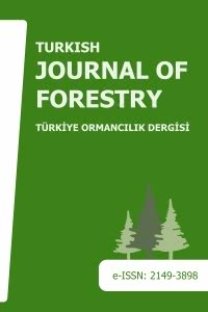Odun kompozitleri
Kompozit terimi farklı iki ya da daha fazla materyalin değişik yapıştırıcılarla bir araya getirilmesiyle oluşturulan malzemeleri ifade eder. Odun kompozitleri terimi ise oldukça yeni bir terimdir ve odunsu materyalin odunsu bir materyal ya da başka bir materyal ile yapıştirılması ya da birleştirilmesiyle elde edilen malzemeleri ifade etmektedir. Orman Ürünleri Endüstrisi 'nde küçük partiküllerin , liflerin ya da daha geniş odun parçalarının bir araya getirilmesiyle geliştirilmiş olan pek çok malzeme değişik isimlerle anılmaktadır. Bu malzemeler son 10-15 yıldır odun kompozitleri adı altında ifade edilmektedir. Bu makalede odun kompozitlerinin tanımı, sınıflandırılması, üretimi ve kullanım alanları tanıtılmaya çalışılmıştır.
Anahtar Kelimeler:
kereste, orta sertlikte lif levha, OSB, yapı malzemeleri, kompozit ahşap, lif levha, şerit yongalı levhalar, lamine odun, kontraplak, etiket yongalevha
Wood composits
The term of "composite" describes the products which are made of two or more materials by bonding them with various glues. On the other hand the term of wood composite is relatively new and is used to describe any material which is produced by gluing or joining of wooden material with other wooden material or the materials other than wood. In the forest product industry .although many different products made by joining small wooden particles, fibres or relatively larger pieces have various names , as a whole, during the last fifteen years, these materials have been described under the name of "wood composites " In this article description, classification, production and usage of wood composite materials were introduced.
Keywords:
timbers, medium density fibreboards, OSB, building materials, composite boards, fibreboards, flakeboards, laminated wood, plywood, waferboards,
___
1. MALONEY,T.M., Terminology and Products Definitions A Suggested Approch to Uniformity Worldwide. In Proceedings, 18 th International Union of Forest Research Organization World Congress, Yugoslavia, September 1986.2. MALLICK,P.K., Composites Engineering Handbook, Marcel Dekker,Inc., Newyork USA, 1997.
3. Forest Products Laboratory, Wood Handbook, Madison,WI: U.S.Department of Agriculture, Forest Service, 1999 [www.fpl.fs.fed.us(2000)].
4. MALONEY,T.M.,The Family of Wood Composite Materials, Forest Products Journal, Vol:46, No:2,1996.
5. BOZKURT, A.Y., GÖKER, Y., Tabakalı Ağaç Malzeme Teknolojisi, İ.Ü.Yayın No:3401, Orman Fak.Yayın No:378, İstanbul,1986.
6. GÖKER, Y., Kontrplak, Laminart Ağustos-Eylül 2000
7. FAO, Plywood and Other Wood –Based Panels, Volume I,II,III,IV,V, Rome,1965.
8. TS 46,Kontrplaklar,TSE,Ankara,1971.
9. HAYGREEN,J.G., BOWYER,J.L., Forest Products and Wood Science,Third Edition. Iowa State Üniversity Press,Ames,Iowa,USA,1996.
10. FRONZAC,F.J., LOEHNERTZ, S.P., Powered back-up roll: New Technology for Peeling Veneer,US.Dept.of Agri. Forest Service, Res. Pap.,FPL-428,1982.
11. MALONEY,T.M., Development of Wood Composite Materials, Res. Pap., Pulmann,Wash.Washington State Univ.Wood Mtl.Lab.1994.
12. YILDIZ MDF A.Ş. www.yildizmdf.com(2000)
13. KUBLER,H., Wood as a Building and Hobby Material, Wiley and sons, Inc.,Canada,1980.
14. TS 180, Yongalevhaları (Yatık yongalı,Genel amaçlar için),TSE,Ankara,1978.
15. TS 1617, Yongalevhaları (Yatık yongalı, yapıda kullanılan), TSE,Ankara,1974.
16. EN 309, Wood Particleboards-Definition and Classification, European Committee Standardisation, Brussell,1992.
17. ÖKTEM,E.,Ormangülü (Rhodendron ponticum L.)Odunundan Yongalevha Yapılması Üzerine Araştırmalar, Doktora Tezi, 1978.
18. NEMLİ,G.,KALAYCIOĞLU,H., Yongalevha Teknolojisi, Laminart, Sayı:7,Nisan-Mayıs 2000.
19. BOZKURT,Y., GÖKER,Y., Yongalevha Endüstrisi Ders Kitabı, İ.Ü.Yayın No:3311, Orman Fak.Yayın No:372, İstanbul,1985.
20. MALONEY,T.M., Modern Particleboard and Dry-Process Fibreboard Manufacturing, Miller Fremann Publ., Inc., California,USA.,1993.
21. ASAN,S., Türkiye’de Yapay Levha Sanayii,H.Ü. Mühendislik Fakültesi, MTYO Ağaç İşleri End.Müh.Böl.(Basılmamış Ders Notu),Ankara,1989.
22. GÖKER,Y., Değişik Yöntemlerle Üretilmiş Yongalevhaların Kullanım Yerleri,Laminart,Sayı:7, Nisan-Mayıs 2000.
23. AKBULUT,T., Yongalevha Endüstrisi,Laminart,Sayı:7, Nisan- Mayıs 2000.
24. AYLA,C., OSB Üretim Teknolojisi, Laminart, Sayı:12,Şubat-Mart 2001
25. KALAYCIOĞLU,H., Neden OSB?, Laminart, Şubat-Mart 2001
26. Structural Board Associıation,http://www.sba-osb.com (2000)
27. HAUPE,R.,SELLERS,T.,et all., Comparisons of Strandboard Made with Phenol-formaldehyde Resin and Resins Modified with TVA Acid- hidrolysis Lignin. Forest Products Journal,44(4),1994.
28. ALAIN,C.,OSB:RawMaterial,Manufacturing,Process, Properties and Uses, http://fraxinus.for.ulaval.ca/osb (2000)
29. http://online.anu.edu.au/Forestry/wood/osb/2.html(2001)
30. SCF, Laminart, Sayı:12, Şubat-Mart 2001.
31. AYRILMIŞ,N., MDF Üretim Teknolojisi, Laminart 1999.
32. GREEN, D. W., HERNANDEZ, R., Standarts for Structural Wood Products and Their Use in the United States, Wood Design Focus, Fall 1998.
33. FREAS,A.D., SELBO,M.L., Fabrication and Design of Laminated Wood Structural Members, USA. Department of Agriculture, Wash. D.C. USA.,1954.
34. ŞENAY,A., Ahşap Lamine Taşıyıcı Elemanların Mekanik Özelliklerinin Belirlenmesi Üzerine Araştırmalar, Doktora Tezi, İ.Ü. Fen Bilimleri Ens. Orman End. Müh. Anabilimdalı,1996.
35. TS 3842, Yapıştırılmış Lamine AhşapYapı Elemanları, Ankara, 1983.
36. MOSLEMİ,A., Inorganic Bonded Wood and Fiber Composite Materials, II. International Inorganic Bonded Wood and Fiber Composite Material Conference,Idaho USA, 1990.
37. YOUNGQUIST,J.A., MYERS, G.E.,et all., Composites from Rcycled Wood and Plastics, Final Rep. US. Environmental Protection Agency project, LAG DW 1293 4608-2, Forest Pro. Lab.Madison,US., 1993 b.
- ISSN: 1302-7085
- Yayın Aralığı: Yılda 2 Sayı
- Başlangıç: 2000
Sayıdaki Diğer Makaleler
Eğirdir Gölü havzası' nın kuraklık etüdü ve tarım-ormancılık açısından değerlendirmesi
Kentsel açık-yeşil alanlar ve Isparta kenti örneğinde irdelenmesi
Kızılçamda sağlıklı fakat gövde formu bozuk ağaçlardan yetiştirilecek bireylerin gövde kalitesi
Abdullah Gezer, Nebi BİLİR, SÜLEYMAN GÜLCÜ
Ahşap malzemede su alımının parafin vaks/bezir yağı karışımıyla azaltılması
